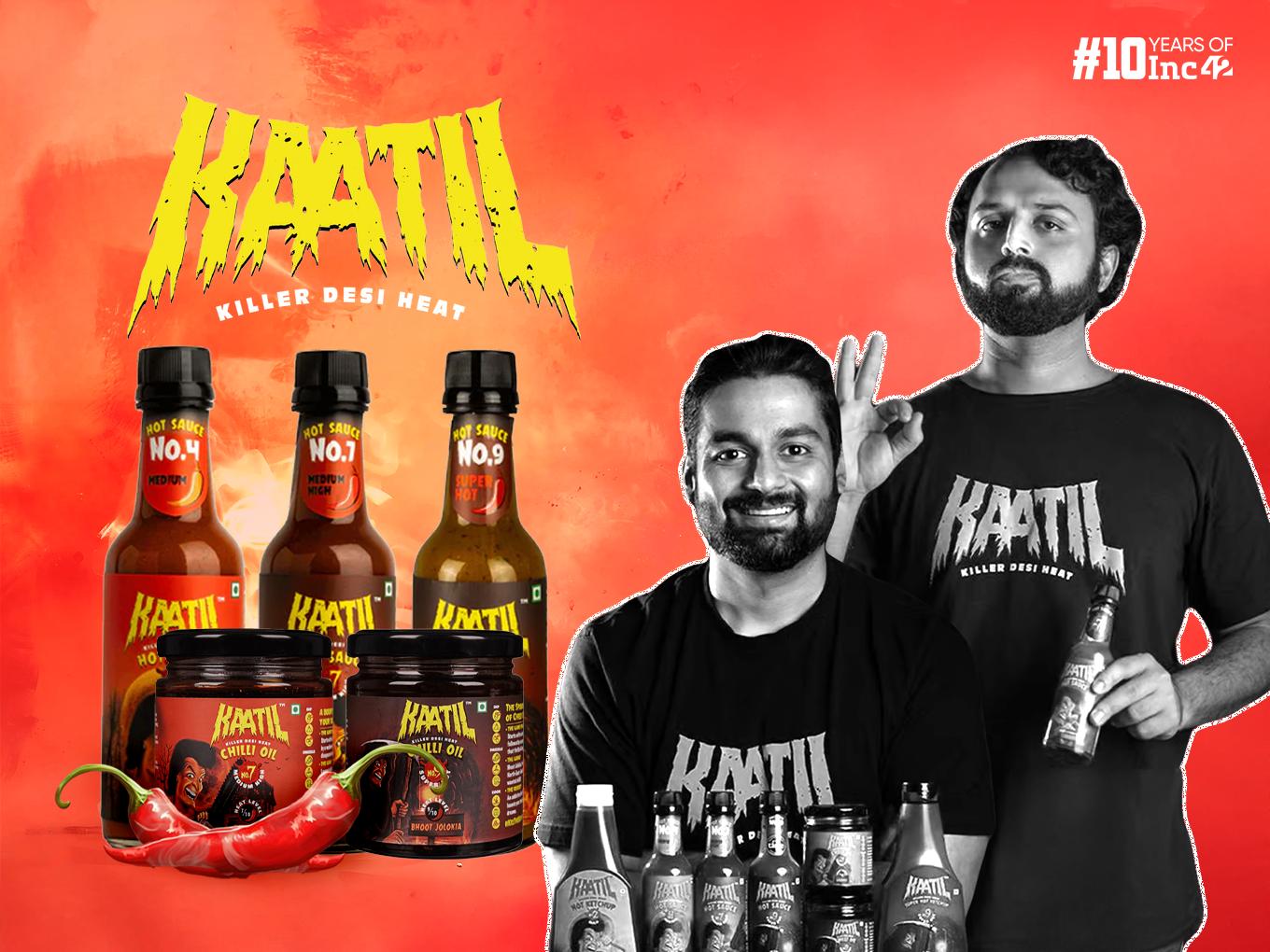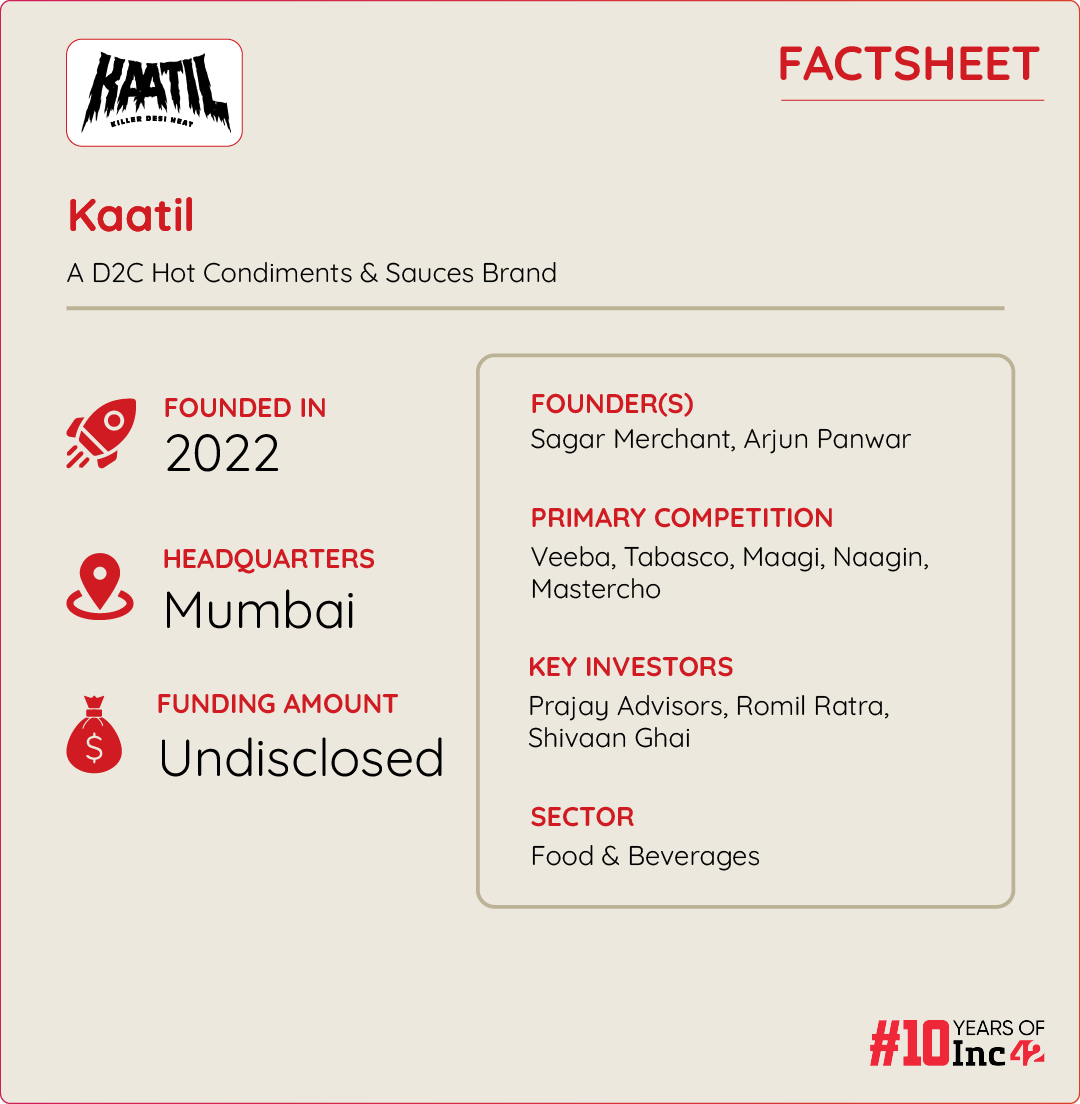Can Kaatil’s Fiery Indian Flavours Challenge Tabasco’s Global Dominance?

Indians’ love affair with spicy foods is no secret. Whether it’s the tongue-tingling heat of different kinds of Indian curries or the fiery kick in street food, bold and intense flavours are a staple of India’s palates. However, with global trends shifting toward healthier eating options, Indians have started to cut back on spices.
But this craving is hard to get rid of, and it is very much evident from the way Korean cuisines have made their way into our lives, encouraging adventurous foodies to embrace “swicy” (sweet and spicy) flavours that push the limits of heat. Globally, too, the demand for spicy food and beverages is on the rise. Even Coca-Cola launched a spicy raspberry flavour soda earlier this year.
Serving the need to satiate the global palate craving for spicy foods and flavours is the global hot sauce market, which is expected to become a $7.9 Bn opportunity by 2032, growing from $5.2 Bn in 2023. However, this space is currently dominated by global giants like Tabasco and Heinz.
Back home, Sagar Merchant and Arjun Panwar (who joined the endeavour later) are laser-focussed on breaking this global dominance with their killer hot condiments and sauces, Kaatil. Founded in 2022, the Indian D2C brand aims to shake up the global condiment scene with the country’s diverse and vibrant range of chillies.
The founders also want to reclaim India’s position as the king of fiery flavours on the world stage. He claims to have generated INR 1.5 Cr revenue in FY24 and projects 2-3X growth in FY25.

Kaatil’s Killer Plot
After completing their graduation in business administration, batchmates Merchant and Panwar went on with their lives. Due to his interest in food, Merchant joined a food studio in Bombay. Here, he started learning about food and food products. The studio was led by a UK-based chef whose family runs the Indian food brand, Patak’s.
At the time, hot sauces, hot condiments, and other sauces (in general) were growing in popularity because people were eating out more, travelling, and becoming more knowledgeable about global condiments. There was also a growing focus on chillies and bold flavours.
This was when the idea to float Kaatil struck him.
“People were used to ketchup and regular chilli sauces. Therefore, I thought why not put the spotlight on Indian chilies? Just like how coffee beans, craft beers, and craft alcohol from India have gained focus as premium ingredients, I believed that chillies were an unexplored gem. This is how Kaatil came into being. The idea has been to create global condiments using Desi chillies at different heat levels,” Merchant said.
Kaatil’s concept is centred around the idea of heat levels (on a scale of 1 to 9). Kaatil’s products follow a distinctive nomenclature system where numbers represent heat levels. For instance, their hot sauces range from “Number 4,” which is medium, to “Number 7,” which is medium-high, and “Number 9,” which is super hot.
This same approach is applied across other categories, like ketchup—”Number 2″ for mild and “Number 9” for very hot. This system simplifies the customer experience, making it easy to choose a product based solely on the heat intensity that suits their preference.
Merchant launched Kaatil with three products—two hot sauces and one hot ketchup—each defined by its unique heat level rather than a typical name. In the last one year, Kaatil has expanded its portfolio with four more unique products, including chilli oils at heat levels “Number 7” and “Number 9,” and an additional hot sauce, “Number 9,” which is the brand’s bestseller made from Bhut Jolokia (Ghost pepper) sourced from Assam.
One of Kaatil’s biggest standout factors is its use of authentic Indian chillies. Each sauce highlights distinct regional flavours — such as Byadgi and Guntur chilies from South India in their “Number 4” sauce, or Lavangi chilies from Kolhapur in “Number 7.”
“These products offer more than just heat; they deliver a nuanced flavour profile reflective of the local cuisine where the ingredients originate. Additionally, we use 2-3 times more ingredients than typical sauces, incorporating fresh vegetables and real chillies, which go through a signature process that enhances their natural smoky and toasted flavours,” Merchant said.
The startup avoids cost-saving shortcuts, like adding oleoresins or chilli extracts in its sauces, and relies on pure, real ingredients sourced from top suppliers. While it does not have direct partnerships with farms, Kaatil ensures that the chilli sources meet high standards of hygiene and quality. These chillies also undergo lab tests and other checks to maintain the integrity of the products.
Kaatil’s products are crafted using an in-house formula and process, developed entirely by Merchant. Despite outsourcing the manufacturing, the startup oversees every detail of the production process, including the precise temperature, time for each step, and ingredient selection.
Inside Kaatil’s Omnichannel Pit
According to Merchant, the startup has been highly focussed on building an omnichannel business from the very beginning, aiming to grow its presence simultaneously across its website, Amazon, other marketplaces, offline retail, and export markets.
“This approach is a conscious decision, based on industry insights. Relying on just one channel can limit awareness among the right audience and lead to overspending on making that single channel profitable while missing opportunities in others. We aim to sustainably grow each channel at a measured pace, ensuring a strong presence at all relevant touchpoints,” he said.
For instance, when expanding into Mumbai’s offline retail market, Kaatil focussed on stores that comprised its ideal customers, rather than spreading itself too thin across all outlets. Similarly, in the US, Kaatil has already launched on Amazon and plans to enter offline retail within the next three to four months. Quick commerce platforms are also part of Kaatil’s future strategy.
Currently, Kaatil claims to have seen strong sales growth across multiple channels, with each product performing well in different markets. One example is its Number 4 and Number 7 hot sauces, which are making waves in offline retail, while the Number 9 hot sauce has set the online market ablaze. In the US, chilli oils are spicing up things and heating up the market.
Meanwhile, per the founder, the startup’s digital customer acquisition strategy revolves around two key avenues — performance marketing and brand building through social media.
The performance marketing strategy focusses on showing potential customers real-world use cases of Kaatil’s products. Hence, the startup leverages content such as videos of actual customer reactions recorded at exhibitions, offline stores, and public events.
The brand also engages with existing customers through WhatsApp, sharing new recipe ideas, launching new products, and collecting feedback to refine their campaigns further.
“For offline customer acquisition, Kaatil relies heavily on tastings through promoters stationed at supermarkets and premium stores. This tasting model allows customers to sample a range of products, and it has been highly effective in increasing average order value,” Panwar said, adding that customers who originally planned to buy one product often end up purchasing two after tasting the variety offered.
Kaatil’s Fiery Future Plans
As of now, the Mumbai-based D2C brand aims to expand its presence across multiple geographies and retail channels. It also aspires to enhance its retail footprint by setting up premium stores in major metros throughout India. It has set a goal of reaching 2,000 stores within the next three years.
Recognising the potential for international success, Kaatil is committed to positioning itself as a premium Indian brand in the global market. The founders see a unique opportunity to fill the gap left by traditional Indian brands abroad.
Financially, Kaatil projects INR 50-100 Cr in revenues over the next three to five years. The company claims to have experienced significant growth, with monthly increases of 25% across individual channels and an overall growth rate of 30% to 40%.
In terms of product expansion, Kaatil plans to launch four to six new products within the next year, exploring additional condiment categories and venturing into ready-to-eat and snacking segments.
However, this transition is not going to be easy, especially when there are other more established new-age brands like Veeba, nutrition-focused D2C brand Troovy, and even handcrafted saucemakers like Masterchow.
The fact of the matter is that Kaatil is just one of the many sauces and condiments brands that India has to offer to this world. Its current playbook, which is Indian chillies, could be easily aped by the existing or new players entering the market, making the brand redundant, unless its flavours are so distinguished that it is hard for its customers to switch to other brands. On the other hand, however, if the brand is able to decode this, it has the potential to become the next Tabasco or Heinz.
[Edited By Shishir Parasher]
The post Can Kaatil’s Fiery Indian Flavours Challenge Tabasco’s Global Dominance? appeared first on Inc42 Media.
No comments